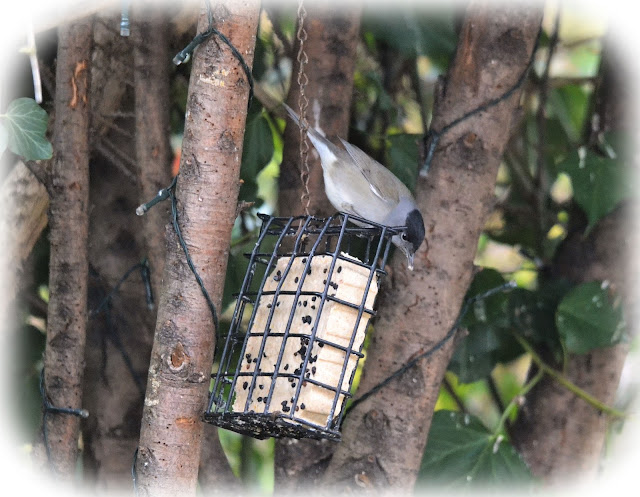March has been a relatively good time around the garden feeding station this year, a few absentees, like the Great Spotted Woodpecker not seen all month, even the local Sparrowhawk has not made an appearance lately , or none that I have witnessed any way, and thankfully the Grey Heron has kept away this year.
One new appearance and one that I have not witnessed in the garden since I moved into this house, a welcome visitor in the form of a Mistle Thrush, in fact not one but a pair.
I managed over the last few days to grab a few record photographs, always seem to be facing away from me. a few sightings on the pear tree, a few on the rooftops. They have been around now for at least a week which makes me wonder if they have nested close by.
 |
| Mistle Thrush on the Pear Tree |

The Pair of Mistle Thrushes |
|
Back to the regulars around the garden, early March there were up to three Blackcaps around the garden, two males and a female, The males appeared to have moved on, but the female is still being seen almost daily, still feeding occasionally on apple, but mainly on the fatball feeders.
The Wren has been seen on the odd occasion, usually moving around the ivy or skulking through the garden shrubs, I managed to catch a glimpse has it moved on to one of the garden fences.
 |
| Wren. |
Blue Tits and great Tits are seen almost every day a couple of Long Tailed Tits were seen on one day only.
 |
| Blue Tit. |
 |
| Great tit |
 |
| Long Tailed Tit. |
Still good numbers of Finches coming to the garden feeders, Chaffinch numbers have increased with both male and female birds being regular feeders.
Goldfinches come to the feeders every day, feeding only on the Niger seeds when the sunflower hearts have all but gone.
Greenfinch sightings have started to decrease has the month has moved on.
 |
| Three regular finches seen in the garden. |
 |
| Greenfinch |
 |
| Chaffinch |
 |
| Goldfinch |
The Ring necked Parakeets still bringing that tropical feel to the garden, they have grown fond of the sunflower hearts and the apple halves.
 |
| Ring necked Parakeet |
Robins seen daily, I noticed one of the Robins with some nesting material in its beak, I suspect nesting in my neighbours garden.
 |
| Robin |
Starlings arrive on mass daily, fatballs seems to be their tipple at the moment, although they appear rather partial to the occasional apple. This one appears to be a male, with the characteristic pale blue around the base of the bill
The House sparrow colony seems to be increasing, regularly visiting the garden feeders daily, love to know where they are nesting though.
 |
| House sparrows and Goldfinch |
Both male and female Blackbirds seen daily, although no nesting activity yet.
 |
| Male Blackbird |
Collared doves have always been regular and extremely territorial , although it's difficult sometimes to recognise who are the resident birds and who are the intruders.
 |
| Collared Dove |
 |
| Wood Pigeon |
Finally a pair of Magpies have been seen daily around the Pear Tree, they did try and nest in the Pear tree last year, I must admit I did try and discourage them,
 |
| Magpie. |
That's nearly seventeen species around the garden this month, which is quite good, I have seen Jackdaws and Carrion Crows on the rooftops but none have entered the garden this year.
Its amazing the number of bird species that do visit suburban gardens, if you take the time to look.



























































